"We'd be up for days drinking, getting stoned and making music": How the Rolling Stones channelled chaos to make the final album with their most potent line-up
When Ronnie Wood, the Stones and some A-list mates holed up at his house to help with his solo album, it sparked a days-long party and a Rolling Stones hit
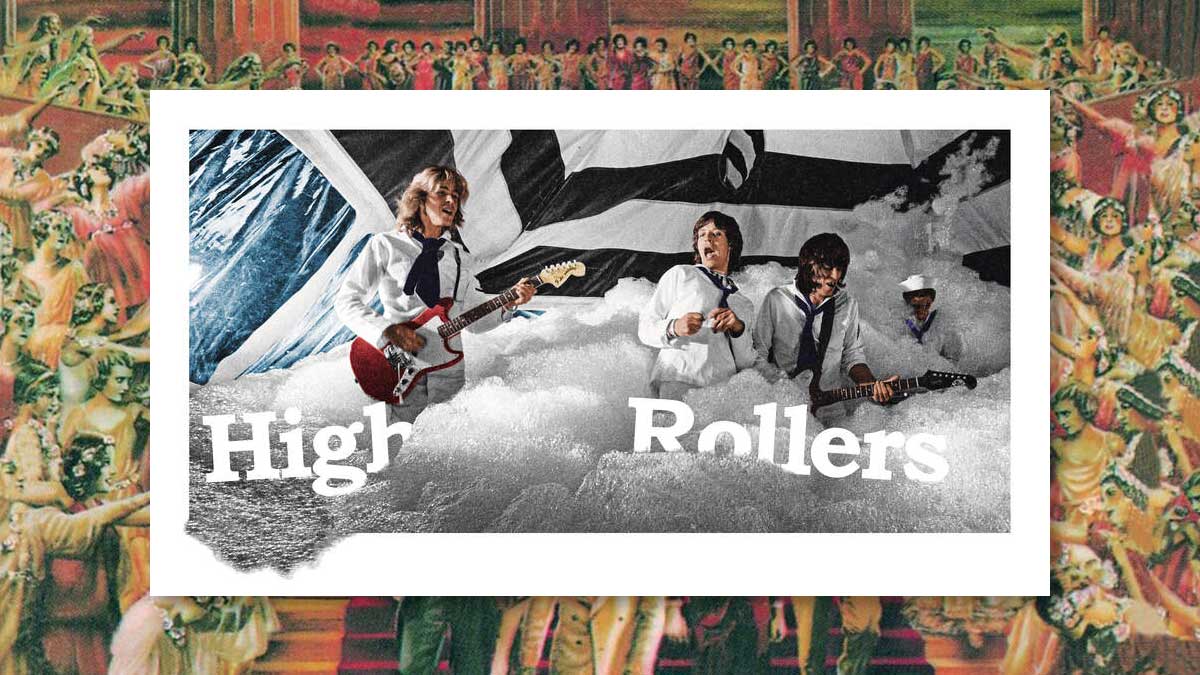
Our story begins one ass-freezing night in January 1974, in the soundproofed basement of The Wick, a splendid Grade 1-listed Georgian townhouse in Richmond, London designed in 1775 for Lady St Aubyn. Two centuries later its owner was 26-year-old cool-as-fuck Rod Stewart/Faces guitarist Ronnie Wood, hawk-nosed member of a new English aristocracy: old-money rock stars.
At the time he bought The Wick, in 1971, Woody was coddled in cash from the double-whammy success that year of Rod’s Maggie May solo single and Every Picture Tells A Story album both going to No.1 in Britain and America simultaneously. Ronnie played guitar and bass on both and co-wrote the title track to Every Picture. He bought it for a suitcase of cash and began filling the basement with recording equipment.
“I didn’t do it with any sort of plan,” he later told me. “It started with somewhere to put my guitars, then a piano, pool table, some drums…”
With time to kill until the start of a Faces Japanese tour, Woody spent the first weeks of 1974 corralling every muso that wound up at The Wick with a joint in their hand to help come up with material for his own forthcoming solo album, I’ve Got My Own Album To Do. Chief among them was Rolling Stones guitarist Keith Richard (still sans ‘s’ back then). Keith and his ‘old lady’, the witchy Anita Pallenberg, had moved into The Wick’s coach house.
Busted for drugs and guns at their Chelsea abode the previous summer, Richard was convinced “the cops were out to get me”, after the judge gave him an unexpectedly lenient sentence of a £250 fine. Woody’s coach house “was a good hideout”.
Other basement regulars included Mick Jagger, George Harrison, Eric Clapton, Rod Stewart, David Bowie, Ringo Starr, Mick Taylor, and various other ‘vibe merchants’ such as rising acting star John Hurt and the crew from Monty Python. “Before any of us knew it we’d be up for days drinking, getting stoned and making music,” Ronnie recalled with a beaky grin.
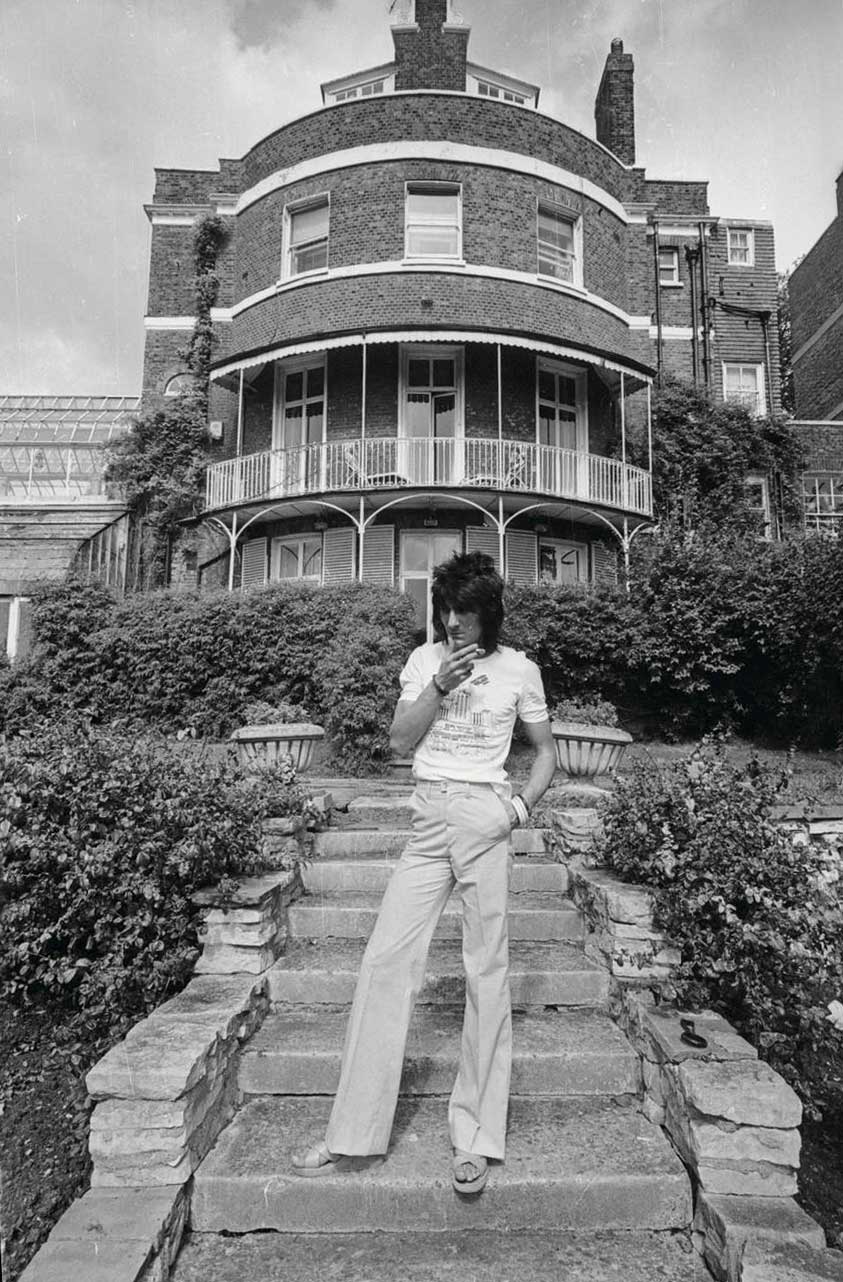
It was during another such journey into night, fuelled by pharmaceutical cocaine, that Woody found himself gleefully jamming with Jagger, Bowie, session bassist Willie Weeks and Faces drummer Kenney Jones on a loose-limbed jingle-jangle that Jagger later described as “a very Chuck Berry song” but with “a different feeling to it than a Chuck Berry song”.
Sign up below to get the latest from Classic Rock, plus exclusive special offers, direct to your inbox!
When Jagger and Bowie started improvising and having fun around the phrase “I know it’s only rock’n’roll but I like it”, it began as a coke-joke take on comedian Dick Emery’s national catchphrase, heard on BBC1 every Saturday night that year: “Ooh, you are awful – but I like you!” Suddenly the whole room was singing along: “I know… it’s only rock and roll… but I like it!”
Some accounts have Bowie whipping out his tenor sax and fattening up the nursery rhyme chorus. Some have Richard elsewhere, with his connection in the coach house. But they kept tooting and returning to it, “…like it… like it… yes, I dooo…” until the sun came up and went back down.
“We all knew it was good,” Ronnie told me matter-of-factly, “but no one thought for a minute it would be such a big hit.” No one except Jagger, who was determined not to leave The Wick without it. The same star-tripping jam also yielded I Can Feel The Fire, the rock’n’reggae track that would open Ronnie’s solo album. “Mick and I cut a deal,” he recalled. “He said: ‘You keep I Can Feel The Fire, I’ll keep It’s Only Rock ’N Roll.’”
Destined to become one of the totemic anthems of classic 70s rock, It’s Only Rock ’N Roll (But I Like It) was only a medium-sized hit by previous Rolling Stones standards when it was released as a single in July 1974 (No.10 in the UK, No.16 in the US). But it became one of the most fitting aphorisms of the times, as 60s ‘we’ became 70s ‘me’.
Suddenly “I know it’s only [insert subject] but I like it” became a good enough excuse for anything. Jagger got it straight away and ran with it. He liked it liked it so much, in fact, he decided they should name the next Stones album after it.
Released in October 1974, It’s Only Rock ’N Roll was the first truly 70s album the Stones would make. It was also the last Stones album to feature their most potent line-up: the one that recorded Let It Bleed, Sticky Fingers and Exile On Main St., three of the greatest rock albums of all time – no arguments allowed. It turned 50 in 2024. Blissfully, it has not grown old gracefully at all.
Despite the accidental birth of its title track, there was little else that was spontaneous about It’s Only Rock ’N Roll. A patchwork of ideas stitched together in a panic by Mick Jagger as he strove to drag the Rolling Stones into a new era, it “was up and down like a toilet seat”, deadpanned Charlie Watts.
By 1973 the Strolling Bones, as NME had started to call them, were showing their age. Jagger and Richard both turned 30 that year – last orders for rock stars in that hope-I-die-beforeI-get-old era. Bill Wyman was 37, for chrissakes – nearly as old as Elvis. Keith – Keef – still sported a chipped front tooth and deathly white pallor, his matted black hair the result of his habit of not sleeping – ever; he bragged that his record was “nine days without a wink”.
When that year he came top in a new NME poll, Rock Stars Most Likely To Die – a title he would hold for 10 years – he shrugged. “It’s like they want me to die,” he drawled, purring with barely concealed pleasure. Jagger, however, saw the danger. Were the Stones becoming a parody of themselves? When comedian Freddie Starr now did his absurdist impersonations of Mick for chortling family audiences on TV, the likeness was disconcertingly uncanny.
On stage they still enjoyed ‘greatest rock’n’roll band in the world’ status, but their latest album, Goats Head Soup, despite going to No.1 in Britain and America, had largely been met by indifference, signposted by the glaciar-paced single Angie. The sight of Richard nodding off in the video summed up most people’s feelings about the song. Meanwhile, Jagger had taken note of all the attention now devoted to ‘glam rock’ stars like Alice Cooper and T.Rex, Roxy Music and David Bowie, all of whom had bigger and better hits in 1973 than the vanilla Angie.
Even junkie-implacable Keef wasn’t immune to the gnawing sense that the Stones were being overtaken. He developed a deep antipathy towards Marc Bolan, skidding to a halt in his silver Ferrari on the King’s Road one day then leaping out with a hunting knife to slash at a T.Rex poster.
Rubbing metatextual salt into the wound came the New York Dolls, fronted by garish Mick ’n’ Keef burlesques David Johansen and Johnny Thunders. When the Dolls appeared on music TV show The Old Grey Whistle Test in November, an ultra-glam, Biba-clad Johansen jokingly told beardy polo-necked presenter Bob Harris that he had “bunny teeth”. After they’d finished miming outrageously, Harris got his own back pronouncing the band “mock rock”.
But it was the Stones who were now being mocked. Jagger chose not to see this as an existential crisis, but rather a career miscalculation, something that could be adjusted and fine-tuned. He had already identified Bowie as the one to beat. Jagger had been there at Hammersmith Odeon when Bowie retired Ziggy that summer, the most celebrated farewell stunt since The Beatles rocked the rooftop.
On the same day in October that the Stones played their final show of the year, in West Berlin, Bowie released Pin Ups, a stopgap album of hurriedly recorded cover versions, which went straight to No.1. Also in the UK top five album chart that week was These Foolish Things, a collection of covers by the only glam artist considered as innovative and stylish as Bowie, Roxy Music frontman Bryan Ferry.
Ferry’s champagne-bubble version of Sympathy For The Devil thrilled Jagger almost as much as Bowie’s same-sex reset of Let’s Spend The Night Together on Aladdin Sane, his earlier No.1 album that year. It reaffirmed the Stones’ connection to the now and suggested a way forward to Jagger. The Stones would do their own covers album, he decided. Unlike Bowie’s mid-60s nostalgia trip, though, the Stones would focus on timeless blues and soul yardsticks.
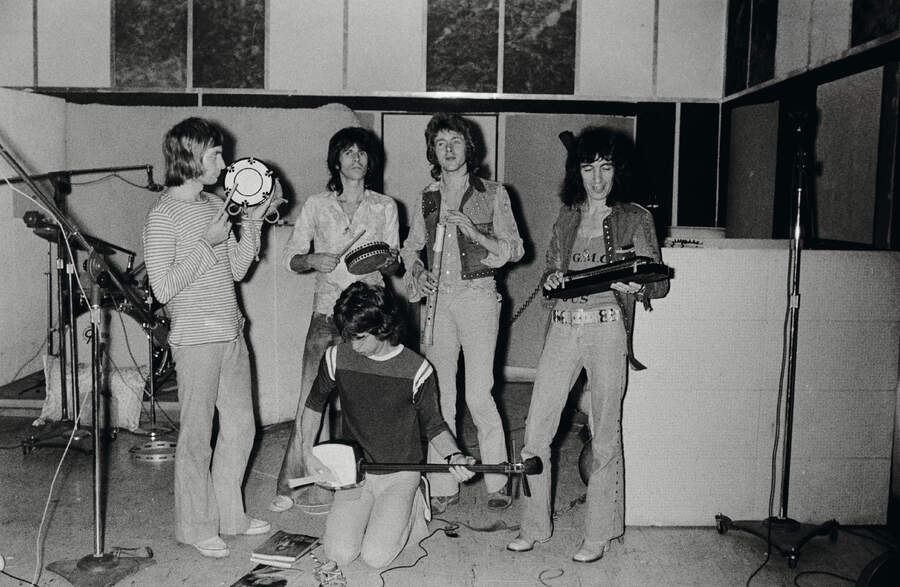
Two weeks in November were booked at Musicland Studios in Munich. There the Stones put their familiar stamp on quickfire stuff like Jimmy Reed’s Shame, Shame, Shame, which they’d done in their club days (and ripped off for Little By Little, the B-side of Not Fade Away, in 1964). They tackled oddities like Trouble’s A-Comin, an obscure Chi-Lites album track from 1970, and embarrassed themselves with an awkwardly pale imitation of Drift Away, the rock’n’soul classic that had just been a huge US hit for Dobie Gray. The only cover that really popped was their proto-punk version of Ain’t Too Proud To Beg, a signature hit from 1966 for Motown stars The Temptations.
According to Richard: “We were really hot [from touring] and ready just to play some new material.” But when he got to Munich the plan had changed to a quickie album: one side covers, one side live recordings. It was a decision taken partly to compensate for Richard’s latest attempt to get clean, at an exclusive Swiss clinic, where his joke about going there to have his drug-contaminated blood changed for some fresh virgin plasma would also enter the lexicon of 70s-hip-speak. Going for a blood change: leave me the fuck alone.
With Keith on Mick’s shit-list (again) for putting his drug habit before the band, the singer filled the time writing with guitarist Mick Taylor. A 20-year-old, non-smoking vegetarian when he joined the Stones in 1969, Taylor was now on the verge of self-destruct. He had become that most pitiable creature: the pampered junkie with enough money to never need to stop.
His exquisite ability to fly his guitar straight into the Sun remained as yet undimmed, however, and the two Micks wrote several numbers together, at least three of which would appear on It’s Only Rock ’N Roll, albeit credited as usual to Jagger/Richard. It had happened before, of course; Stones songs Taylor should have received a co-writing credit for. Back when he didn’t know what to say. Taylor was now 24 and a million miles from then and he vowed it would not happen again.
“I felt I should have been credited with co-writing on It’s Only Rock ’N Roll,” he said in 1997. He and Jagger had been “quite close friends and co-operated quite closely on getting that album made”. Jagger, however, rolled his eyes and allowed that Taylor “maybe threw in a couple of chords”.
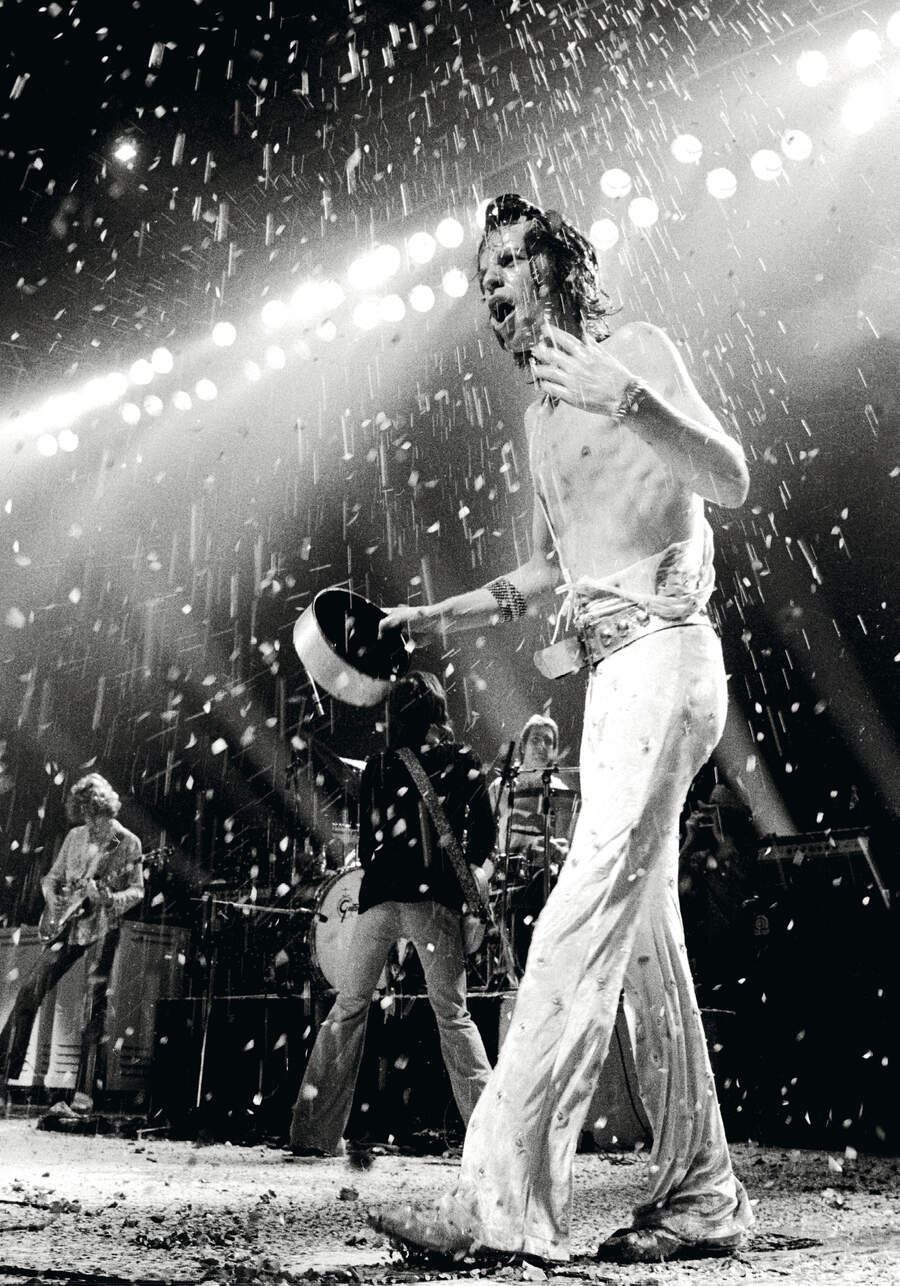
When recording sessions reconvened at Island Studios in London in February 1974, Jagger began with the Wick demo of the now officially titled It’s Only Rock ’N Roll (But I Like It).
As Keith later told Ronnie: “I took the precaution of removing your guitar parts.” They did leave Woody’s 12-string acoustic in the mix, however, along with Kenney Jones’s drums, with Charlie Watts generously claiming he “wouldn’t have done it any other way”. Willy D. Weeks’s bass was also retained. As were Bowie and Wood’s backing vocals – that’s them singing ‘like it, like it, yes I do’, although Bowie’s vocals are so low in the mix you’d never know.
As with Taylor, neither Wood nor Bowie would receive a co-writing credit. That so peeved Bowie that he retaliated by writing Rebel Rebel – a straight take-off of the Stones classic (I Can’t Get No) Satisfaction. According to Alan Parker, an uncredited guitarist on the track, Bowie said: “I’ve got this riff and it’s a bit Stonesy, I just want to piss Mick off a bit.”
Jagger’s growing rivalry with Bowie is at the heart of It’s Only Rock ’N Roll. Bowie had started it when he referred to Jagger by name on his 1973 hit Drive-In Saturday. Four months later the Stones released Angie, and Jagger allowed rumours to flourish that it had been written after a tryste he’d had with Bowie’s wife Angie.
While the Stones were working on It’s Only Rock ’N Roll, Bowie was across town recording Diamond Dogs. When Rebel Rebel was a hit in February ’74, Jagger shrugged it off. But when he discovered that his first choice to design the next Stones album sleeve, Guy Peellaert – then at peak fame for Rock Dreams, his ’73 book of impressionistic paintings of rock stars – had also agreed to provide a painting for Bowie’s album, Jagger was livid.
Sure enough, Peellaert’s painting of a naked half-man half-dog Bowie with full canine genitalia on display remains more celebrated than the orgiastic fin de siècle that adorned the sleeve of It’s Only Rock ’N Roll.
Jagger was now a man on a mission. He took the bones of the Munich covers, inlaid some new material, and padded it out with leftovers from the Goats Head Soup sessions at Dynamic Studios in Jamaica the year before. Following the firing of long-time Stones producer Jimmy Miller, whose smack habit had become “a problem”, Mick and Keith now co-produced the album under the suitably 70s nom de plume The Glimmer Twins.
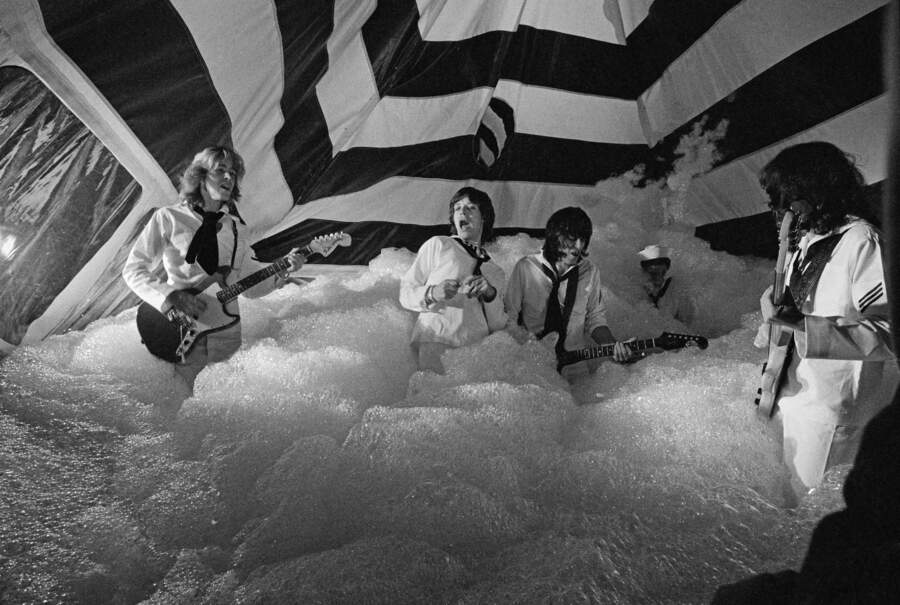
The finished results were patchy, at best. Opening track If You Can’t Rock Me set the tone with its trite doubleentendre chorus and jaded delivery, its overexcited pleased-tameetcha guitars and no-messing drums. ‘Now I ain’t looking for no pretty face,’ Jagger yowls, ‘or for some hooker working roughish trade…’
It may not possess the tank-like force of Brown Sugar or the cinematic scope of Gimme Shelter, but as a trigger-happy album opener If You Can’t Rock Me lit things up. The mix might be muddy but the message was crystal: it’s the 70s, baby, get over it.
The juddering cover of Ain’t Too Proud To Beg that followed was the Marmite selection. Taking The Temptations’ smooth-talking original and punching it up with such power-chord energy was not to everyone’s taste. Unless you were high. Then it sounded daring.
The impish title track, half Wood’s Wick demo, half Mick’s retooling, was the real clincher. Richard told Jagger: “Come on, we’ve got to steal that motherfucker back. And we did, without too much difficulty. Just the title itself was so beautifully simple.”
Side one’s obligatory big ballad, Till The Next Goodbye, was another from the Jagger-Taylor collaboration, and was so arch it could have been one of Lou Reed’s sick jokes, the ringing acoustic guitars and Jagger’s high-camp vocal suggestive of the idea, introduced by Angie, that he could no longer sing a love song with a straight face.
Indeed, the idea that the Stones might come up with something new or original were concepts that felt almost quaint in 1974. That is until the track that closed side one, a new peak in the more heightened musical arc Mick Taylor had introduced to the Stones, the imperious Time Waits For No One.
Another Jagger and (uncredited) Taylor original, Time Waits For No One is simply a masterpiece, a journey not a race that builds and builds until the tension is released by Taylor, marinading in smack and Santana, who delivers an exquisitely tortured solo. A siren sound over midnight rooftops. Jagger’s lyrics like suicide right on the page: ‘Time can tear down a building or destroy a woman’s face/Hours are like diamonds, don’t let them waste…’ His voice tremulous and pained: ‘…dreams of the night-time will vanish by dawn…’
Side two of It’s Only Rock ’N Roll also suffered from a 50-50 hit ratio, beginning with the ick-inducing Luxury. Demoed during the Goats Head Soup sessions, Luxury is toe-curling to listen to now, Jagger chirruping in a fauxJamaican accent: ‘I’m working so hard, to keep you in dee luckshurry…’
Dynamic’s owner Byron Lee claimed Jagger had originally written a reggae song called Man Eating Woman, which he planned to hire a Jamaican band to record, for a mooted solo album. Certainly reggae was breaking through to the rock mainstream, with both Zeppelin (D’Yer Maker) and Eric Clapton (a cover of Bob Marley’s I Shot The Sheriff) ‘dabbling’ successfully with the form around the same time.
“I think reggae could be as popular as the blues,” reckoned Mick. “Black music is all about getting into a groove. What matters is where you put your feet and how you wiggle your ass.”
Dance Little Sister, which followed, was all about wiggling your ass. Pure Keef, it starts promisingly with a nasty, snub-nosed riff and some Rebel Rebel-style lyrics (‘On Thursday night she looked a fright…’) but soon descends into repetitiveness and cliché, so that it’s a relief when it finally ends. Same with Short And Curlies, a bawdy barrelhouse blues featuring Taylor’s adroit honkytonk guitar. Another leftover from the Goats Head Soup sessions, a song about a woman squeezing a man’s hairy balls, was never likely to transcend its tawdry subject matter regardless of how deftly it was performed.
Sandwiched between those obvious fillers, though, was one of the album’s surprise highlights, If You Really Want To Be My Friend. Unlike the fey and prissy Till The Next Goodbye, If You Really Want To Be My Friend was the most heartfelt love song Jagger had written since Wild Horses. It’s a song about grown-up sentiments such as true sexual freedom, real platonic love, and the bile that builds when those things are quashed or denied in a relationship.
In this case, Jagger’s troubled marriage to Nicaraguan-born beauty Bianca Pérez-Moras Macias, whom he wed in St Tropez in May 1971 when she was four months pregnant. ‘I know you think life is a thriller/You play the vamp, I play the killer…’ When he goes on to sing about how ‘people tell me you’re a vulture… Say you’re a sore in a cancer culture’, it’s clear the jive talk is over. That Jagger the cunning deceiver is for once being honest. With Philly Soul outfit Blue Magic adding lush backing vocals, and the band – augmented by regular guest keyboard players Nicky Hopkins and Billy Preston – at their most tasteful, If You Really Want To Be My Friend is an unexpected moment of emotional truth on an album otherwise built to grind its groin muscles.
“I’m not in the least domesticated,” Jagger told Viva magazine. “I try not to hang around my family any more than I have to.” In the same article, Bianca pondered: “Perhaps Mick isn’t attracted to me any more.” A disingenuous remark, given that at the time she was in an on-off affair with Hollywood movie star Ryan O’Neal. While Mick, as Bianca put it, “screws many but has few affairs”.
The album ends on a Kafka-esque note with Fingerprint File. A funky chunk of post-Watergate paranoia, it’s the longest track on the album and its most mysterious. Many critics disliked what they saw as it’s tricksy production – the treated lead vocal, the manipulated guitars, the phased, deliberately woozy production. Adding to the sense of otherhood, Jagger plays rhythm guitar, Mick Taylor plays bass, Bill Wyman switched to synthesiser, Charlie Watts was supported by tabla player Jolly Kunjappu, and Keith enjoyed himself hugely on Superfly-style wah-wah guitar.
Looking back, Keith put it best when he observed: “Rock’n’roll can’t be planned or prepared. Goats Head Soup to me was a marking-time album. I like it in many ways but I don’t think it has the freshness this one has.”
In America, It’s Only Rock ’N Roll became the fourth of eight consecutive Stones albums to go to No.1. In Britain it reached No.2, breaking an unbroken chain of No.1 albums going back to 1969’s Let It Bleed. Music videos were shot for several of the songs. The most famous is the one for It’s Only Rock ’N Roll (But I Like It) featuring the band, for reasons never made clear, in US Navy sailor suits performing in a tent, which gradually fills with foam – again, for reasons no one could be bothered to decipher.
Videos were also done for Ain’t Too Proud To Beg and Till The Next Goodbye. But when the It’s Only Rock ’N Roll single proved to be a poor-selling follow-up to Angie, plans for further singles were quietly shelved. Ain’t Too Proud To Beg became the second and last single from the album, scraping the Top 20 in the US, but was not released in Britain.
By January 1975, Mick Taylor had officially quit the Stones. The official reason given was that he wanted “a change of scene”. Richard sent him a telegram: “Thanks for the past five years – it’s been a pleasure working with you.” Jagger took it as a personal betrayal and remarked sarcastically: “No doubt we can find a brilliant six-foot-three blond guitarist who can do his own make-up.”
Meanwhile, back in the smoky basement of The Wick, Keith, his new gold tooth glinting, turned to Ronnie and asked: “I know it’s only rock’n’roll, but how about it?” To which Ronnie replied: “I like it, like it, yes I dooo…” Honest.
Mick Wall is the UK's best-known rock writer, author and TV and radio programme maker, and is the author of numerous critically-acclaimed books, including definitive, bestselling titles on Led Zeppelin (When Giants Walked the Earth), Metallica (Enter Night), AC/DC (Hell Ain't a Bad Place To Be), Black Sabbath (Symptom of the Universe), Lou Reed, The Doors (Love Becomes a Funeral Pyre), Guns N' Roses and Lemmy. He lives in England.




